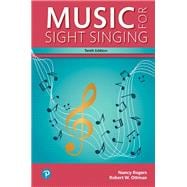For courses in sight singing and music theory.
The most celebrated, engaging, and musical sight-singing text on the market
A freshly updated edition of the classic musical textbook, Music for Sight Singing, 10th Edition, is structured around organized melodies, drawn from the literature of composed music and a wide range of the world’s folk music. Real music exercises allow readers to practice sight singing and develop their “mind’s ear,” the ability to imagine how music sounds without first playing it on an instrument. The new edition includes even more melodies and several new topics; improved introductions to minor keys, pre-dominant leaps, and chromaticism; and increased use of bass and C clefs — while retaining the simple-to-complex arrangement that lays the foundation for success.










